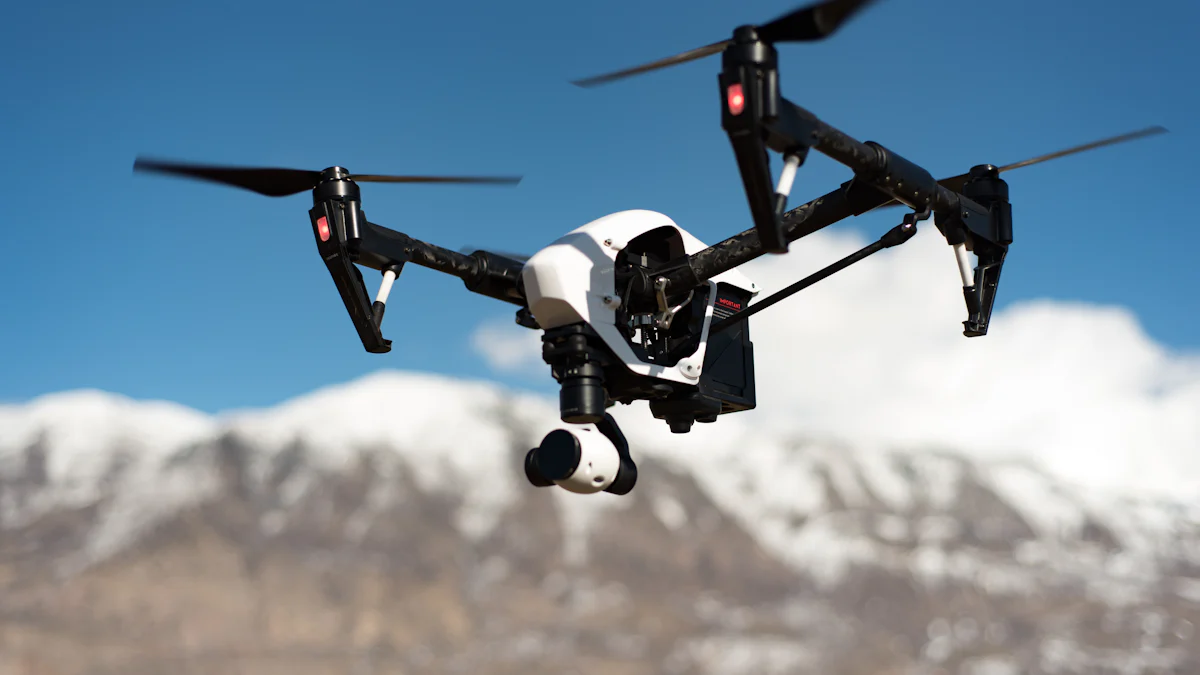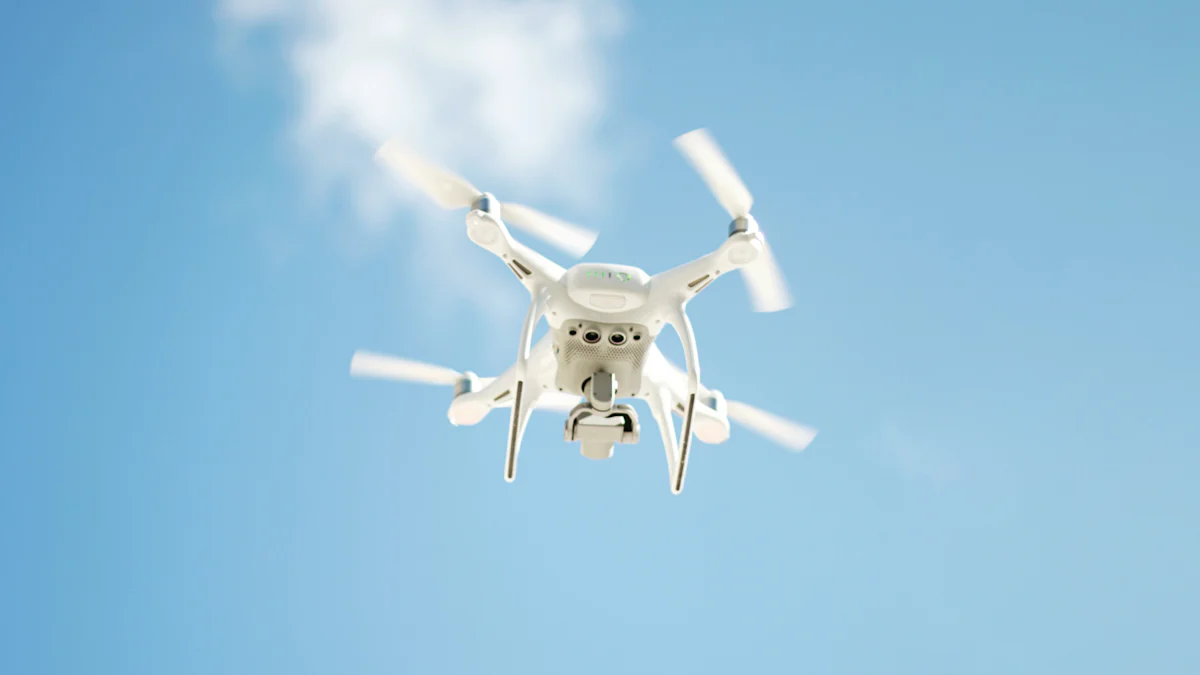
Drone technology plays a pivotal role in modern industries. The global drone market is projected to surpass US$ 51 billion by 2027. This growth highlights the increasing significance of drones across various sectors. Rapid advancements in technology drive this expansion. Innovations such as swarm technology enable multiple drones to communicate and collaborate in real-time. The agriculture sector alone anticipates growth from USD 4.98 billion in 2023 to US$ 18.22 billion by 2030. Staying informed about these trends is crucial. The emergence of the new style drone, equipped with cutting-edge features, showcases the need for continuous updates.
New Style Drone: Autonomous Drones
Advancements in AI and Machine Learning
Artificial Intelligence (AI) and Machine Learning (ML) have transformed drone technology. AI-powered navigation systems allow drones to navigate complex environments with precision. These systems process vast amounts of data in real-time. Drones can avoid obstacles and optimize flight paths. This capability enhances efficiency and safety in operations.
AI-based data analysis tools enable drones to perform complex tasks autonomously. These tools analyze images and sensor data. Drones can identify patterns and anomalies. This feature proves invaluable in industries like agriculture and construction. The automation of data processing reduces human error and speeds up decision-making.
Impact on Drone Navigation
AI advancements have revolutionized drone navigation. Drones equipped with AI can fly autonomously over long distances. These drones use sensors and algorithms to maintain stability and direction. The ability to navigate without human intervention opens new possibilities. Drones can now operate in remote or hazardous areas. This advancement increases the scope of drone applications.
Real-world Applications
Autonomous drones find applications in various fields. In search and rescue operations, drones assist human searchers by covering large areas quickly. Programming drones for autonomous search trajectories enhances their effectiveness. Drones equipped with thermal cameras locate missing persons in challenging terrains.
In agriculture, drones monitor crop health and optimize irrigation. AI-driven analysis provides farmers with actionable insights. This technology improves yield and reduces resource wastage. Autonomous drones also play a role in environmental monitoring. These drones collect data on air quality and wildlife populations.
Challenges and Limitations
Despite their potential, autonomous drones face challenges. Regulatory frameworks struggle to keep pace with technological advancements. Governments must establish clear guidelines for drone operations. Regulations ensure safety and privacy in the skies. Compliance with these rules remains a significant hurdle for drone manufacturers and operators.
Regulatory Hurdles
Regulatory hurdles impact the deployment of autonomous drones. Authorities require drones to meet safety standards. Operators must obtain permits and licenses. These requirements vary across regions. Navigating this regulatory landscape poses challenges for businesses. Harmonizing regulations globally would facilitate wider adoption of drone technology.
Technical Constraints
Technical constraints limit the capabilities of autonomous drones. Battery life restricts flight duration. Drones rely on lightweight materials to extend flight time. Advances in battery technology aim to address this issue. However, achieving significant improvements remains a challenge. Technical constraints also affect payload capacity. Drones must balance weight and functionality to perform effectively.
Enhanced Imaging Capabilities

High-Resolution Cameras
High-resolution cameras have transformed the capabilities of the new style drone. These cameras capture detailed images, providing valuable data for various industries. Surveying and mapping benefit significantly from this technology. Drones equipped with high-resolution cameras create accurate maps and models. This precision aids in urban planning and infrastructure development.
Media and entertainment industries also utilize high-resolution cameras. Filmmakers and photographers use drones to capture stunning aerial shots. These images offer unique perspectives, enhancing visual storytelling. The new style drone enables creative professionals to explore new possibilities in visual media.
Benefits for Surveying and Mapping
Surveying and mapping require precise data collection. High-resolution cameras on drones provide this accuracy. Drones fly over large areas, capturing detailed images. These images help create 3D models and topographic maps. Surveyors use this data to plan construction projects and monitor land changes.
Use in Media and Entertainment
The media and entertainment sectors embrace drone technology. High-resolution cameras capture breathtaking aerial footage. Filmmakers use drones for dynamic shots in movies and documentaries. Photographers explore new angles and perspectives. The new style drone expands creative possibilities in visual arts.
Thermal and Multispectral Imaging
Thermal and multispectral imaging enhance the functionality of the new style drone. These imaging technologies detect heat and analyze light spectra. Drones equipped with these cameras serve various industries. Agriculture and search and rescue operations benefit from these advancements.
Applications in Agriculture
Agriculture relies on accurate data for crop management. Drones with thermal and multispectral cameras monitor crop health. These cameras detect temperature variations and plant stress. Farmers use this information to optimize irrigation and fertilization. The new style drone improves efficiency and productivity in agriculture.
Use in Search and Rescue Operations
Search and rescue operations face challenging environments. Drones with thermal cameras locate individuals in difficult terrains. These cameras detect body heat, even in dense vegetation. The new style drone assists rescuers by covering large areas quickly. This capability enhances the effectiveness of search missions.
Swarm Technology

Coordination and Communication
Swarm technology in drones represents a significant leap forward in coordination and communication. Algorithms play a crucial role in enabling swarm behavior among drones. These algorithms allow multiple drones to work together seamlessly. Each drone communicates with others to perform tasks efficiently. The new style drone uses advanced algorithms for real-time data exchange. This capability enhances the collective performance of drones in a swarm.
Military and civilian sectors both benefit from swarm technology. Military applications include surveillance and reconnaissance missions. Swarms of drones can cover vast areas quickly. This approach provides comprehensive intelligence gathering. Civilian uses include entertainment displays and environmental monitoring. Drone swarms create stunning visual effects in light shows. Environmental scientists use swarms for data collection over large ecosystems. The new style drone excels in these applications due to its advanced features.
Potential Risks and Ethical Concerns
Swarm technology introduces potential risks and ethical concerns. Privacy issues arise when drones operate in populated areas. Drones equipped with cameras can capture sensitive information. The new style drone must adhere to strict privacy regulations. Ensuring compliance with these regulations is essential for public trust.
Security threats also pose challenges in swarm technology. Unauthorized access to drone swarms can lead to misuse. Hackers may exploit vulnerabilities in communication systems. Protecting the integrity of drone operations is paramount. The new style drone incorporates robust security measures. These measures safeguard against unauthorized access and data breaches.
Extended Flight Time and Range
Battery Innovations
New Materials and Designs
Drone technology has seen significant advancements in battery innovations. Engineers have focused on developing new materials that enhance energy storage. These materials improve the overall performance of drones. Lightweight designs contribute to longer flight durations. Researchers explore options like lithium-ion batteries for aerial vehicles. These batteries offer potential improvements in efficiency. The goal is to extend the operational range of drones significantly.
Impact on Drone Efficiency
Battery innovations directly impact drone efficiency. Enhanced batteries allow drones to fly longer without recharging. This improvement increases the productivity of drone operations. Industries benefit from extended flight times. Surveying and mapping tasks become more efficient. Drones can cover larger areas in a single flight. The need for frequent battery replacements decreases. This reduction leads to cost savings for businesses.
Alternative Power Sources
Solar-Powered Drones
Solar-powered drones represent a promising alternative energy source. These drones harness solar energy through photovoltaic cells. The cells convert sunlight into electricity. This process powers the drone’s systems. Solar power extends flight times by providing continuous energy. Drones equipped with solar panels can operate in remote areas. This capability proves valuable for environmental monitoring. Solar-powered drones reduce reliance on traditional batteries. This shift contributes to eco-friendly drone technology.
Hydrogen Fuel Cells
Hydrogen fuel cells offer another alternative power source for drones. These cells generate electricity through a chemical reaction. Hydrogen combines with oxygen to produce energy. This process emits only water vapor as a byproduct. Hydrogen fuel cells provide a clean energy solution for drones. The technology enhances flight duration and range. Drones powered by hydrogen fuel cells can perform longer missions. This advancement supports applications in logistics and delivery services. The use of hydrogen fuel cells aligns with sustainability goals.
Drone technology continues to evolve with groundbreaking advancements. These trends hold immense significance for various industries. Autonomous drones, enhanced imaging, and swarm technology are reshaping operations. Staying informed about these innovations is crucial. Understanding these changes impacts industries and daily life. The future of drone technology promises revolutionary applications. Readers should explore further developments in this dynamic field. The potential of drones to reach remote areas with minimal human effort makes them invaluable tools. Embracing these advancements will ensure readiness for the future.


